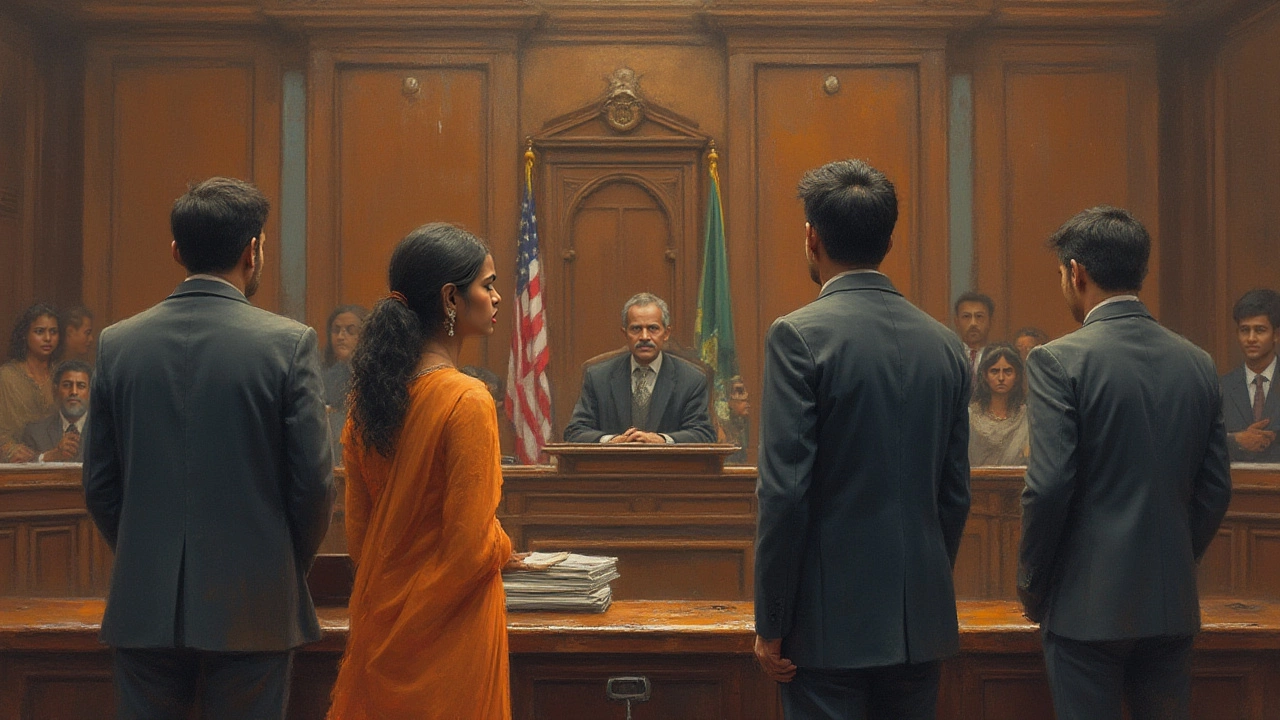Ever wondered if you can end your marriage without your spouse’s agreement in India? That question isn’t just floating around late-night WhatsApp chats—it’s a real concern for thousands. Marriages get complicated; sometimes a partner disappears, sometimes dialogue just isn’t possible. Indian law handles these situations in a very specific way, different from what you might see in movies or read online forums. Understanding what “one-sided divorce” actually means, how it works here, and what your real options are can save you time, money, and a bunch of stress. Let’s get to the facts and shake off the social taboos.
What Does One-Sided Divorce Really Mean in Indian Law?
So, is a one-sided divorce in India even possible? The legal answer is yes, but it’s not as simple as filing a form and walking away. In India, divorce typically happens in two ways—by mutual consent (where both parties agree to end the marriage) or through a contested process (where only one spouse wants out). When people say "one-sided divorce," they’re talking about what law calls a contested divorce.
Here’s the fine print. For a contested divorce, you can file a petition on specific legal grounds listed under different marriage laws: the Hindu Marriage Act (1955) for Hindus, the Special Marriage Act (1954) for others, plus laws for Christians, Parsis, and Muslims. Some accepted reasons include cruelty (mental or physical), adultery, desertion for more than two years, conversion to another religion, mental disorder, and venereal disease. Unlike in mutual consent, here your spouse doesn’t need to agree. You file the petition, your lawyer drafts the required paperwork, and then you head to the appropriate family court with your story.
But—and this is huge—the court will not blindly grant a divorce because you filled out a form. You need to prove your case with real evidence: hospital records for abuse, police complaints for violence, proof your spouse deserted you, or even details about extra-marital affairs, if that’s what happened. Merely saying you’re not happy or you “don’t love each other anymore” won’t cut it. The court’s standards are strict because marriage is a legal contract, not just a social ritual.
Is this process quick? Not even close. Contested divorces are infamous for dragging on—often anywhere between three to seven years, depending on your city, your lawyer, and your luck with the court schedule. Sometimes it takes several court hearings, witness cross-examinations, and repeated attempts at reconciliation. Judges may order mediation or counseling sessions in case there’s a chance the marriage can be saved, especially if kids are involved.
One more thing: you can file for divorce anywhere you (the petitioner) live, where the marriage was registered, or where you last lived together as a couple. This point actually matters, especially for people who’ve relocated for work or left their marital home because of problems.
If you want to see where you fit, check out the main grounds allowed under law:
- Cruelty (Mental or Physical)
- Desertion for Two or More Years
- Adultery
- Conversion to Another Religion
- Mental Disorder
- Incurable Leprosy or Venereal Disease
- Spouse Missing for Seven Years or More
- Renunciation of the World (like joining a religious order)
Divorce laws for Christians, Muslims, Parsis, and under Special Marriage Act differ on some details. But for one-sided divorce, the baseline remains: grounds must be proven and accepted by the court.
Here’s a quick reference table to clarify the different divorce grounds applicable to major marriage laws in India in 2025:
| Law | Main Grounds for One-Sided Divorce |
|---|---|
| Hindu Marriage Act, 1955 | Cruelty, Adultery, Desertion, Conversion, Insanity, Leprosy, Renunciation, Missing for 7 years |
| Special Marriage Act, 1954 | Same as above |
| Indian Divorce Act, 1869 (for Christians) | Adultery, Cruelty, Desertion, Conversion, Insanity |
| Parsi Marriage and Divorce Act, 1936 | Same as above |
So, if you’re considering this path, check which law covers your marriage, because it’ll decide your procedure and your options.

The Contested Divorce Process: Step-by-Step Guide and What to Expect
If you’re gearing up for a one-sided divorce, expect a rollercoaster. But knowing the ride helps. The first step is always filing the divorce petition. Your lawyer (don’t try this alone) will draft a detailed petition that describes your marriage, how things fell apart, your specific allegations (with facts, not just feelings), and what remedies you seek (like custody, alimony, or protection from harassment).
Once the petition is ready, it gets filed in the family court where you, the respondent, or both last lived together. After the first filing, the court will issue a notice to your spouse. If they respond, the legal battle begins—written replies, evidence from both sides, and likely some bitter cross-questioning.
Here’s how the journey typically looks, step by step:
- Petition filed — You explain your grounds with supporting facts.
- Notice sent — The court officially informs the other party.
- Response and hearing — Your spouse replies in writing or may contest your claims.
- Mediation/counseling — Courts often make you attend sessions to see if things can resolve peacefully. Not just a formality; judges push hard here.
- Evidence and trial — Things go to the next level. You (and maybe your witnesses) get cross-examined. Your spouse gets the same chance. Evidence matters a lot; WhatsApp chats, photos, medical records, and call logs have all been used as proof. Courts don’t like drama, but they do like hard evidence.
- Orders on interim matters — Need maintenance during the trial? Worried about kids? Courts can pass temporary orders for alimony, child custody, or protection from abuse (like restraining orders).
- Final arguments — Your lawyers sum up the case. The judge listens closely to both sides.
- Judgment — The court decides. Sometimes, judges grant the divorce and other reliefs (like custody, maintenance). If not convinced, they can dismiss your petition.
- Appeal — Unhappy with results? Orders can be appealed in higher courts, but this adds extra years to the fight.
Don’t ignore the stress factor. Contested divorce can take a toll—emotionally, financially, even physically. Your private life will be discussed in public, witnesses (sometimes reluctant relatives) dragged into court. It’s exhausting.
Money also matters. Legal fees, documentation charges, and possible multiple trips to the court all add up. On average in cities like Delhi, Mumbai, or Bengaluru, a contested divorce could cost anywhere from ₹70,000 to several lakhs, depending on complexity and who you hire. If the other side wants to stretch things, delay tactics are common. Expect frustration. If you have kids, courts will always try to ensure their best interests—but single custody awards are now rare. Joint custody or shared parenting is the growing trend since the last few years.
Here’s a practical comparison between the contested (one-sided) and mutual consent divorce timelines based on 2025 data:
| Type | Time Required (average) | Easier? |
|---|---|---|
| Mutual Consent Divorce | 6-18 months | Yes, if both agree |
| Contested Divorce (one-sided) | 3-7 years | No, complex |
Got a spouse who has disappeared? You can still try one-sided divorce. Courts may require you to serve notice through public advertisement (like a newspaper ad) before proceeding ex-parte (in absentia). In 2025, digital summons and video hearings are fairly common, which can speed up wait times if your spouse lives in another city. But documentation remains king—keep everything organized.
People often ask, “Will my spouse’s refusal to attend court mean instant divorce for me?” No. Absence doesn’t equal agreement. But if after repeated summons they don’t appear, courts can proceed without them. But again, without proof, the court will not grant divorce just because the other side isn’t present.
If you make a false allegation, courts have the right to slap you with penalties or dismiss your case. Remember the law cares about “grounds”, not “reasons”—only what’s listed in law counts. So if your reason isn’t on the list, rethink your strategy.
If things get really messy, think about discussing your case with a family counselor or mediator. Sometimes, negotiation outside court can save you years of battles and mountains of legal bills. This option is getting more support from courts as of 2025—judges even recommend it in sensitive cases, especially where kids are involved.

Tips, Rights, and Common Mistakes: What You Should Know Before Filing
If you’re planning to file for a one-sided divorce in India, preparation is everything. Start by collecting all exit-proof: WhatsApp chats, call logs, rent agreements, medical records—every boring detail can save you later. If the reason is physical violence, get medical certificates and file a police complaint immediately; fresh reports are more believable than archived files.
If the case involves child custody, bring proof of expenses, school records, and maybe even testimonials from teachers or neighbors. The court looks at “child welfare” first, not just income levels.
Maintenance and alimony can look different for both men and women. If you’re not earning, you can claim maintenance. Men, too, can claim maintenance in some cases—ditch the stereotype that it’s only a woman’s right.
Key mistakes to watch for: don’t exaggerate facts or invent stories. If the other side proves you lied, you could lose the case and get stuck with extra costs. Avoid publicizing your case on social media—it can backfire. Resist discussing settlement amounts outside the mediation process or without your lawyer’s consent.
As of 2025, remember—courts accept electronic evidence: emails, messages, video calls recorded lawfully. But they're picky. If you manipulate the data, it can be dismissed outright.
Many people feel scared about going to court alone, especially women. Look for free legal aid clinics run by the state or NGOs; some states now have helpdesks right in the Family Court buildings. Also, many procedures have gone hybrid—preliminary hearings or document review via video call save you both time and unnecessary trips.
Here are some tips to strengthen your one-sided (contested) divorce case:
- Document everything: conversations, payments, incidents, visits
- Keep copies of all notices sent and received
- Always attend court dates; skipping hearings can damage your case
- Ask your lawyer about interim reliefs if you’re facing harassment
- If you move cities for work or safety, update the court with new address
- Stay off social media about your case
- If mediation is offered, approach it openly—even if just to speed things up
- Explore government legal aid if budget is a problem
- Use email/WhatsApp only as per privacy laws (don’t hack accounts or record calls without consent—that’s a crime)
One sore spot is cost: legal fees and time lost. Unless you get legal aid, contested divorces are expensive. In 2025, the average legal fee per appearance for a mid-level lawyer in Delhi is about ₹3,000–₹5,000; senior lawyers charge way more. Filing fees and paperwork come extra. If your spouse uses delay tactics (frequent adjournments, no-shows, fresh appeals), courts now penalize such behavior, but that doesn’t always stop the drama.
A mistake people often make is moving new partners into their life before the divorce is final. Legally, that’s a problem—courts have dismissed divorce petitions and even filed counter-cases of adultery if either side gets careless. Wait for your decree!
Divorce laws in India can be both liberating and restrictive. The right to file for divorce, even without your spouse’s consent, is a vital tool, but it comes loaded with paperwork, waiting, and heavy emotional baggage. Talk to professionals, and keep your support system close. As someone who’s seen friends tangled in family courts for years—or quietly finalize things through smarter negotiation—I see the difference clarity, documentation, and solid legal advice makes. Don’t believe every WhatsApp myth about "express divorce." In India, the court’s word is final, and every case tells its own story.
